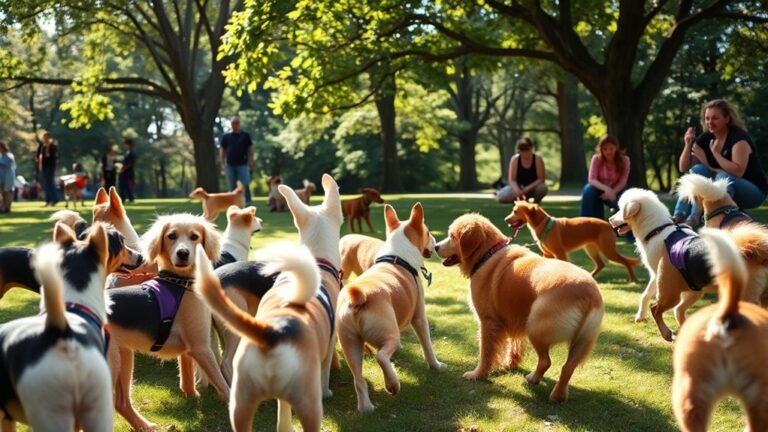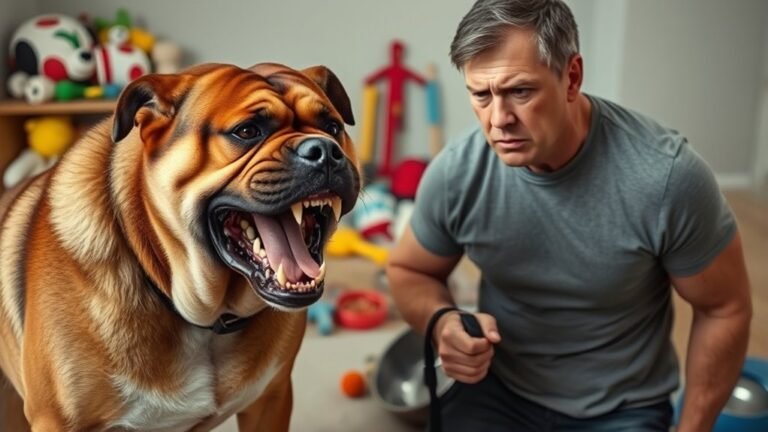Positive Reinforcement: Raising a Happy Dog
To raise a happy dog, use positive reinforcement. This means you give rewards for good behavior. Rewards can be treats, praise, or playtime. When you reward your dog, you help them learn what you want them to do. This makes your bond stronger.
Positive reinforcement builds trust. It also keeps your dog from feeling stressed. Instead of punishing your dog for mistakes, focus on what they do right. This creates a happier and more confident pet.
There are many fun ways to use positive reinforcement. Start with simple commands. When your dog does what you ask, give them a reward. This method makes learning fun!
Are you ready to help your furry friend learn and grow? Let's make training a happy time for both of you!
Key Takeaways
- Use treats, praise, and toys to motivate your dog and reward good behaviors.
- Try clicker training to clearly show your dog what you want.
- Keep training sessions short, about 5 to 10 minutes, so your dog stays focused and happy.
- Be consistent with your commands and rewards. This helps your dog understand better.
- Build a strong bond with your dog using positive reinforcement. Make training fun and rewarding for both of you!
Understanding Positive Reinforcement
When you learn about positive reinforcement, you discover a great way to train dogs. This method rewards good behaviors, making your dog want to do them again. Instead of punishing mistakes, you help your dog improve and learn happily.
You can use treats, praises, or toys to motivate your dog. These rewards make them want to repeat the actions you like.
With consistent practice and some patience, you'll create a strong bond based on trust. By focusing on what your dog does right, you show them they belong in your home.
Try using positive reinforcement, and watch your dog grow and learn with you. It will be a fun journey for both of you!
The Science Behind Positive Reinforcement
Positive reinforcement is a smart way to train dogs, and it works because of science. It uses a method called operant conditioning. This means you reward your dog for good behavior. When you do this, your dog learns and changes how it acts.
Think about this:
- Your dog sits when you ask because it knows a treat is coming.
- Your dog wags its tail when it hears a clicker sound, linking that sound with something good.
- Your dog fetches a ball because it gets a cuddle afterward.
By understanding these ideas, you create a happy space for your dog to learn.
You're not just training; you're building a strong bond. This bond brings trust and joy into your dog's life.
Use this simple and fun approach, and watch your friendship grow!
Benefits of Positive Reinforcement for Your Dog
Using positive reinforcement is a great way to train your dog. It makes training fun and helps your dog feel good. When you reward your dog for good behavior, you help them learn what you want them to do. Plus, it builds a strong bond between you and your furry friend.
Dogs love praise! When you cheer them on, it makes them feel confident and eager to learn more. This method creates a happy space for you both, lowering stress for everyone involved.
You'll notice that your dog repeats the good behaviors you reward them for. This way, you can teach without using fear or punishment.
Overall, positive reinforcement helps your dog become happy and well-adjusted. It encourages them to please you and gives them a sense of belonging in your shared adventure.
Essential Techniques for Effective Training
Effective training techniques help your dog learn quickly and happily. Using clicker training can make your sessions fun for both you and your pup. Good timing is very important! You need to give a reward right away when your dog does something you like. This helps them learn.
Here are some simple tips to help you train your dog better:
- Use clicker training to show the exact moment your dog does the right thing.
- Practice reward timing; give treats right after the click to get the best results.
- Keep sessions short and fun—aim for 5 to 10 minutes to keep your dog excited.
With these tips, you can create a happy learning experience for you and your dog!
Choosing the Right Rewards
Choosing the right rewards can make training your dog a lot more fun! To motivate your pup, think about different kinds of rewards like treats, praise, and playtime. Treats are usually the favorite, but make sure they're small and healthy. Positive words can work wonders too—your dog's tail will wag with joy when you use a happy tone!
It's important to give the reward right away after your dog does something good. This helps them learn what you want them to do.
Mixing up the rewards keeps things fresh and exciting. When you pick the right rewards and give them at the right time, you'll create a happy space for both of you.
This makes training a fun adventure you can share together!
Common Mistakes to Avoid
Training your dog is a fun and rewarding experience, but it's easy to make mistakes. Here are some common errors to watch out for:
- Timing errors: If you give a treat after your dog does something, but you wait too long, your dog may not understand why they got the treat. Try to give rewards right away.
- Unrealistic expectations: Dogs need time to learn new commands. If you expect them to learn something immediately, you might feel frustrated. Be patient and give them time to understand.
- Inconsistent signals: If you use different words or signals for the same command, it can confuse your dog. Use the same word and action every time to help them learn better.
Creating a Positive Learning Environment
Creating a great training experience for your dog starts with a happy learning space. Make sure the area is safe and clear of distractions. Fill it with your dog's favorite toys to make it fun. Use treats and praise to reward good behavior. This will make each training session exciting!
Be consistent with your commands. This helps build trust between you and your dog. Keep training sessions short and playful to keep your dog's attention. Celebrate small wins together. This builds confidence and makes your dog feel included.
When you focus on positivity, you teach your dog better. Plus, you grow closer together. Together, you can create a happy and friendly space where learning is fun!
Frequently Asked Questions
How Long Should Training Sessions Be for My Dog?
Training sessions for your dog should be short. Aim for 5 to 10 minutes of training time. Take breaks often. This helps keep your dog interested and happy. When training is fun, both you and your dog enjoy it more. Always remember to be consistent. That's how you both will succeed!
Can Positive Reinforcement Work for Older Dogs?
Yes, positive reinforcement can really help older dogs! It's important to go at their speed. Keep training sessions short and fun. Celebrate their wins to boost their confidence. This will make them feel loved and part of your family!
What if My Dog Ignores the Rewards?
If your dog ignores the rewards, think about what they like and what might distract them. Try using different treats or toys. Also, make the area quiet to help your dog focus on you. Engage their interest with your voice or movement to bring their attention back. This way, they might pay more attention and get excited!
How Can I Tell if My Dog Is Happy?
To know if your dog is happy, watch their body language. Happy dogs have relaxed ears and wagging tails. They also like to play and run around. These signs mean they feel good. Trust your feelings and enjoy happy times with your furry friend!
Is Positive Reinforcement Effective for All Dog Breeds?
Positive reinforcement usually works for most dog breeds. However, different breeds can have unique traits that make training a bit tricky. It's important to understand your dog's specific needs and personality. This way, you can create a training plan that fits them well. When you do this, you can build a strong bond with your dog and better understand each other. Remember, training should be fun for both you and your dog!







